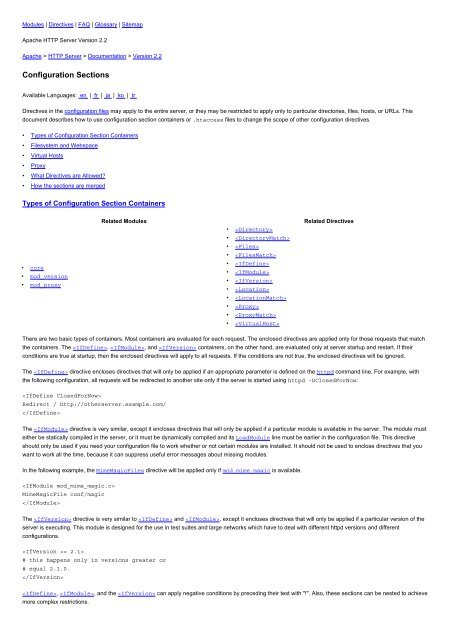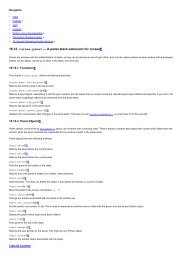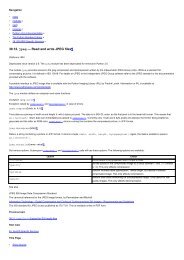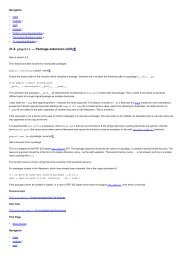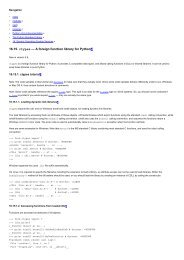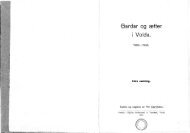Configuration Sections - Apache HTTP Server
Configuration Sections - Apache HTTP Server
Configuration Sections - Apache HTTP Server
Create successful ePaper yourself
Turn your PDF publications into a flip-book with our unique Google optimized e-Paper software.
Modules | Directives | FAQ | Glossary | Sitemap<br />
<strong>Apache</strong> <strong>HTTP</strong> <strong>Server</strong> Version 2.2<br />
<strong>Apache</strong> > <strong>HTTP</strong> <strong>Server</strong> > Documentation > Version 2.2<br />
<strong>Configuration</strong> <strong>Sections</strong><br />
Available Languages: en | fr | ja | ko | tr<br />
Directives in the configuration files may apply to the entire server, or they may be restricted to apply only to particular directories, files, hosts, or URLs. This<br />
document describes how to use configuration section containers or .htaccess files to change the scope of other configuration directives.<br />
• Types of <strong>Configuration</strong> Section Containers<br />
• Filesystem and Webspace<br />
• Virtual Hosts<br />
• Proxy<br />
• What Directives are Allowed?<br />
• How the sections are merged<br />
Types of <strong>Configuration</strong> Section Containers<br />
• core<br />
• mod_version<br />
• mod_proxy<br />
Related Modules<br />
• <br />
• <br />
• <br />
• <br />
• <br />
• <br />
• <br />
• <br />
• <br />
• <br />
• <br />
• <br />
Related Directives<br />
There are two basic types of containers. Most containers are evaluated for each request. The enclosed directives are applied only for those requests that match<br />
the containers. The , , and containers, on the other hand, are evaluated only at server startup and restart. If their<br />
conditions are true at startup, then the enclosed directives will apply to all requests. If the conditions are not true, the enclosed directives will be ignored.<br />
The directive encloses directives that will only be applied if an appropriate parameter is defined on the httpd command line. For example, with<br />
the following configuration, all requests will be redirected to another site only if the server is started using httpd -DClosedForNow:<br />
<br />
Redirect / http://otherserver.example.com/<br />
<br />
The directive is very similar, except it encloses directives that will only be applied if a particular module is available in the server. The module must<br />
either be statically compiled in the server, or it must be dynamically compiled and its LoadModule line must be earlier in the configuration file. This directive<br />
should only be used if you need your configuration file to work whether or not certain modules are installed. It should not be used to enclose directives that you<br />
want to work all the time, because it can suppress useful error messages about missing modules.<br />
In the following example, the MimeMagicFiles directive will be applied only if mod_mime_magic is available.<br />
<br />
MimeMagicFile conf/magic<br />
<br />
The directive is very similar to and , except it encloses directives that will only be applied if a particular version of the<br />
server is executing. This module is designed for the use in test suites and large networks which have to deal with different httpd versions and different<br />
configurations.<br />
= 2.1><br />
# this happens only in versions greater or<br />
# equal 2.1.0.<br />
<br />
, , and the can apply negative conditions by preceding their test with "!". Also, these sections can be nested to achieve<br />
more complex restrictions.
Filesystem and Webspace<br />
The most commonly used configuration section containers are the ones that change the configuration of particular places in the filesystem or webspace. First, it is<br />
important to understand the difference between the two. The filesystem is the view of your disks as seen by your operating system. For example, in a default<br />
install, <strong>Apache</strong> resides at /usr/local/apache2 in the Unix filesystem or "c:/Program Files/<strong>Apache</strong> Group/<strong>Apache</strong>2" in the Windows filesystem.<br />
(Note that forward slashes should always be used as the path separator in <strong>Apache</strong>, even for Windows.) In contrast, the webspace is the view of your site as<br />
delivered by the web server and seen by the client. So the path /dir/ in the webspace corresponds to the path /usr/local/apache2/htdocs/dir/ in the<br />
filesystem of a default <strong>Apache</strong> install on Unix. The webspace need not map directly to the filesystem, since webpages may be generated dynamically from<br />
databases or other locations.<br />
Filesystem Containers<br />
The and directives, along with their regex counterparts, apply directives to parts of the filesystem. Directives enclosed in a<br />
section apply to the named filesystem directory and all subdirectories of that directory. The same effect can be obtained using .htaccess files. For<br />
example, in the following configuration, directory indexes will be enabled for the /var/web/dir1 directory and all subdirectories.<br />
<br />
Options +Indexes<br />
<br />
Directives enclosed in a section apply to any file with the specified name, regardless of what directory it lies in. So for example, the following<br />
configuration directives will, when placed in the main section of the configuration file, deny access to any file named private.html regardless of where it is<br />
found.<br />
<br />
Order allow,deny<br />
Deny from all<br />
<br />
To address files found in a particular part of the filesystem, the and sections can be combined. For example, the following<br />
configuration will deny access to /var/web/dir1/private.html, /var/web/dir1/subdir2/private.html,<br />
/var/web/dir1/subdir3/private.html, and any other instance of private.html found under the /var/web/dir1/ directory.<br />
<br />
<br />
Order allow,deny<br />
Deny from all<br />
<br />
<br />
Webspace Containers<br />
The directive and its regex counterpart, on the other hand, change the configuration for content in the webspace. For example, the following<br />
configuration prevents access to any URL-path that begins in /private. In particular, it will apply to requests for http://yoursite.example.com/private,<br />
http://yoursite.example.com/private123, and http://yoursite.example.com/private/dir/file.html as well as any other requests<br />
starting with the /private string.<br />
<br />
Order Allow,Deny<br />
Deny from all<br />
<br />
The directive need not have anything to do with the filesystem. For example, the following example shows how to map a particular URL to an<br />
internal <strong>Apache</strong> handler provided by mod_status. No file called server-status needs to exist in the filesystem.<br />
<br />
SetHandler server-status<br />
<br />
Wildcards and Regular Expressions<br />
The , , and directives can each use shell-style wildcard characters as in fnmatch from the C standard library. The<br />
character "*" matches any sequence of characters, "?" matches any single character, and "[seq]" matches any character in seq. The "/" character will not be<br />
matched by any wildcard; it must be specified explicitly.<br />
If even more flexible matching is required, each container has a regular expression (regex) counterpart , , and<br />
that allow perl-compatible regular expressions to be used in choosing the matches. But see the section below on configuration merging to<br />
find out how using regex sections will change how directives are applied.<br />
A non-regex wildcard section that changes the configuration of all user directories could look as follows:
Options Indexes<br />
<br />
Using regex sections, we can deny access to many types of image files at once:<br />
<br />
Order allow,deny<br />
Deny from all<br />
<br />
What to use When<br />
Choosing between filesystem containers and webspace containers is actually quite easy. When applying directives to objects that reside in the filesystem always<br />
use or . When applying directives to objects that do not reside in the filesystem (such as a webpage generated from a database), use<br />
.<br />
It is important to never use when trying to restrict access to objects in the filesystem. This is because many different webspace locations (URLs)<br />
could map to the same filesystem location, allowing your restrictions to be circumvented. For example, consider the following configuration:<br />
<br />
Order allow,deny<br />
Deny from all<br />
<br />
This works fine if the request is for http://yoursite.example.com/dir/. But what if you are on a case-insensitive filesystem? Then your restriction could<br />
be easily circumvented by requesting http://yoursite.example.com/DIR/. The directive, in contrast, will apply to any content served from<br />
that location, regardless of how it is called. (An exception is filesystem links. The same directory can be placed in more than one part of the filesystem using<br />
symbolic links. The directive will follow the symbolic link without resetting the pathname. Therefore, for the highest level of security, symbolic links<br />
should be disabled with the appropriate Options directive.)<br />
If you are, perhaps, thinking that none of this applies to you because you use a case-sensitive filesystem, remember that there are many other ways to map<br />
multiple webspace locations to the same filesystem location. Therefore you should always use the filesystem containers when you can. There is, however, one<br />
exception to this rule. Putting configuration restrictions in a section is perfectly safe because this section will apply to all requests regardless of<br />
the specific URL.<br />
Virtual Hosts<br />
The container encloses directives that apply to specific hosts. This is useful when serving multiple hosts from the same machine with a<br />
different configuration for each. For more information, see the Virtual Host Documentation.<br />
Proxy<br />
The and containers apply enclosed configuration directives only to sites accessed through mod_proxy's proxy server that match the<br />
specified URL. For example, the following configuration will prevent the proxy server from being used to access the cnn.com website.<br />
<br />
Order allow,deny<br />
Deny from all<br />
<br />
What Directives are Allowed?<br />
To find out what directives are allowed in what types of configuration sections, check the Context of the directive. Everything that is allowed in <br />
sections is also syntactically allowed in , , , , , , and <br />
sections. There are some exceptions, however:<br />
• The AllowOverride directive works only in sections.<br />
• The FollowSymLinks and SymLinksIfOwnerMatch Options work only in sections or .htaccess files.<br />
• The Options directive cannot be used in and sections.<br />
How the sections are merged<br />
The configuration sections are applied in a very particular order. Since this can have important effects on how configuration directives are interpreted, it is<br />
important to understand how this works.<br />
The order of merging is:<br />
1. (except regular expressions) and .htaccess done simultaneously (with .htaccess, if allowed, overriding )
2. (and )<br />
3. and done simultaneously<br />
4. and done simultaneously<br />
Apart from , each group is processed in the order that they appear in the configuration files. (group 1 above) is processed in the<br />
order shortest directory component to longest. So for example, will be processed before . If multiple sections apply to the same directory they are processed in the configuration file order. <strong>Configuration</strong>s<br />
included via the Include directive will be treated as if they were inside the including file at the location of the Include directive.<br />
<strong>Sections</strong> inside sections are applied after the corresponding sections outside the virtual host definition. This allows virtual hosts to override the<br />
main server configuration.<br />
When the request is served by mod_proxy, the container takes the place of the container in the processing order.<br />
Later sections override earlier ones.<br />
Technical Note<br />
There is actually a / sequence performed just before the name translation phase (where Aliases and DocumentRoots are<br />
used to map URLs to filenames). The results of this sequence are completely thrown away after the translation has completed.<br />
Some Examples<br />
Below is an artificial example to show the order of merging. Assuming they all apply to the request, the directives in this example will be applied in the order A > B<br />
> C > D > E.<br />
<br />
E<br />
<br />
<br />
D<br />
<br />
<br />
<br />
B<br />
<br />
<br />
<br />
C<br />
<br />
<br />
A<br />
<br />
For a more concrete example, consider the following. Regardless of any access restrictions placed in sections, the section will be<br />
evaluated last and will allow unrestricted access to the server. In other words, order of merging is important, so be careful!<br />
<br />
Order deny,allow<br />
Allow from all<br />
<br />
# Woops! This section will have no effect<br />
<br />
Order allow,deny<br />
Allow from all<br />
Deny from badguy.example.com<br />
<br />
Available Languages: en | fr | ja | ko | tr<br />
Copyright 2009 The <strong>Apache</strong> Software Foundation.<br />
Licensed under the <strong>Apache</strong> License, Version 2.0.<br />
Modules | Directives | FAQ | Glossary | Sitemap


